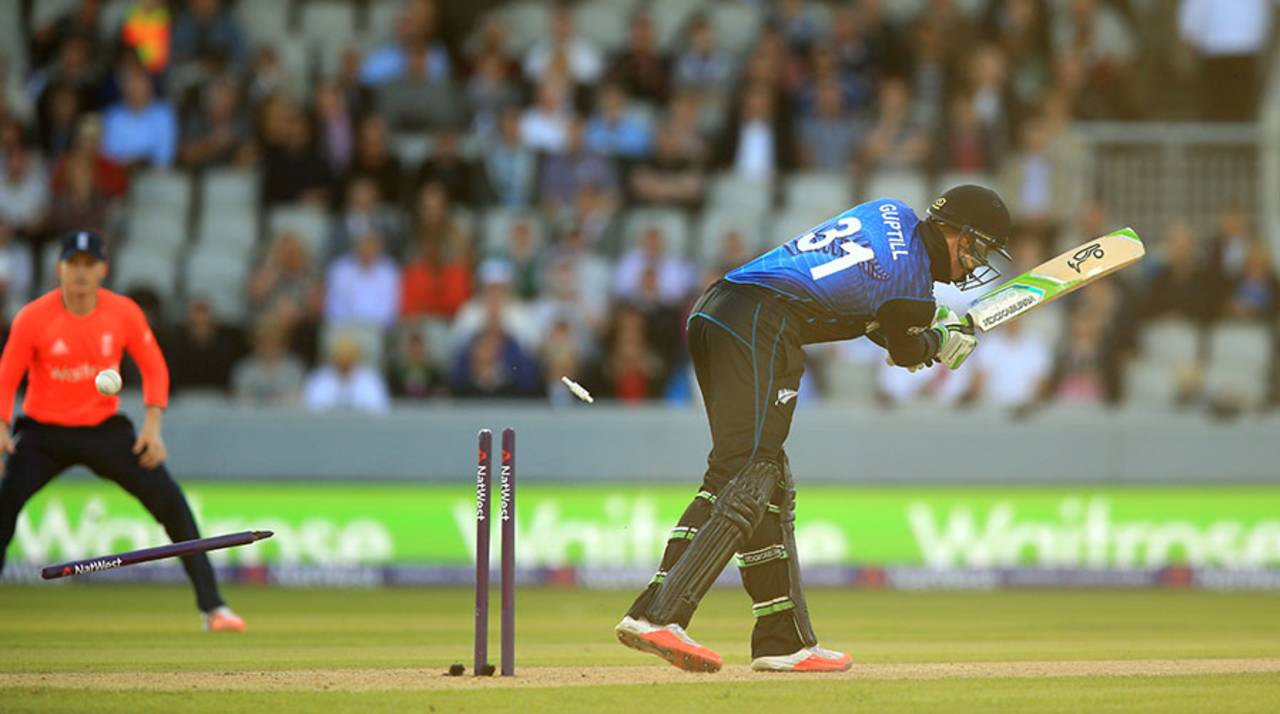New Zealand coach
Mike Hesson could have been a contestant on
Mastermind, such was the considered thought he gave this closed-ended question:
"Are you pleased with your side's overall performance on the England tour?"
"I think it's a pass," he said, in the wake of the
56-run T20 loss to complete the series at Old Trafford. The hesitation was testament to Hesson's character. He opted not to give a flippant answer, and realises England's improvement to take overall honours and deliver New Zealand shock limited-overs defeats takes some explaining.
As the hosts devote their attention to the Ashes, New Zealand exited as model
tourists: competitive, sportsmanlike and beatable. Their 1-1 Test series draw and 3-2 ODI loss made compelling viewing, even if the latter was skewed in favour of bat, with a record 3151 runs scored for a series of five matches or less.
The tour could be diced many ways. Each leg of the series slipped from New Zealand's grasp. Victory is now the default expectation for a team ranked third in the Test and 50-over formats. The ODI losses, after having trounced England by eight wickets on the way to the World Cup final, were particularly galling.
However, a 199-run victory in the
second Test, at Headingley, just New Zealand's
fifth in 54 Tests in England and the first in 16 years, meant the country's best era of
undefeated series in the longest format continued - they are now up to seven. Every player delivered significant runs or wickets.
That was tempered by a
first Test in which a short-pitched bowling plan backfired against Ben Stokes. He inspired England, who had been in a dire position on the opening day at 30 for 4, to a second innings of 478, with an 85-ball century, the quickest at Lord's. The hosts escaped.
New Zealand continued their aggressive ODI brand and the batting strike rates were excellent, but England trumped the visitors at their own game. A dominant 2-1 series position was squandered. That included setting 350 to win in the
fourth match, which England eclipsed with 36 balls to spare. The bowling also proved a letdown in the decider. England swatted a rain-adjusted 192 with one of the 26 overs to spare.
Injuries to Trent Boult and Corey Anderson hindered New Zealand's capability, as did
Brendon McCullum opting to debut ring-in and top Ford Trophy wicket-taker Andrew Mathieson in the
final ODI because Mitchell McClenaghan had lost form.
Hesson lamented the loss in the
final match, the T20 that left the scales of satisfaction teetering. The loss of five wickets for four runs in 1.5 overs chasing 192 signalled a capitulation. Hesson's response that "it was a very poor finish [to the tour]" and "amateur shots would be the nicest way to put it" in relation to the dismissals, means fans can expect the side's approach to undergo the cricketing equivalent of laparoscopic surgery ahead of next year's World T20 in India.
"It's difficult when you finish with such a poor last hour," Hesson said of the tour. "It leaves a sour taste but there were good things. We found out about some players leading into the next phase of short-form cricket."
Hesson singled out
Mitchell Santner as one. The 23-year-old impressed through the ODI series and was New Zealand's best bowler in the T20 bowler with 2 for 28 from his allotment. Dropping a skier off match winner Jonny Bairstow in the deciding ODI was his only obvious glitch.
Details and personnel will likely be reassessed ahead of the limited-overs tour to Zimbabwe and South Africa in August, and the release of the latest batch of annual contracts next month.
Despite the top seven's consistency in all formats over the last 19 months, an uneasy reliance is building on
Kane Williamson and
Ross Taylor to guarantee a platform for victory. The two contributed significant Test runs but their average of 117.50 in four ODI stands resonated. They have
nine century stands in 37 partnerships at 50-over level. The 206-run effort at Southampton was
the highest by New Zealand for the third wicket against any country, surpassing Adam Parore and Ken Rutherford's 180 against India in Vadodara in 1994, and the highest for any New Zealand wicket
against England, overtaking the unbeaten 165-run opening stand between Brendon McCullum and Jesse Ryder at Hamilton in 2008.
Taylor's 43.03 from 152 innings slots in next. He scored consecutive ODI centuries for the fourth time; Martin Guptill (twice) and Mark Greatbatch (once) are the other New Zealanders to achieve the feat.
As for McCullum, there's speculation he may have played his 254th and last one-day international. The 33-year-old, who puts his fragile back through an arduous regime each game, said he is yet to decide his coloured-clothing future. If he retires from ODIs, he will bow out as one of New Zealand's finest captains, taking the national side to their first World Cup final.
His
winning record from 56 ODIs in charge (excluding three no results) is 58%. That rises to 62% (28 from 45 completed matches) once he was officially handed the captaincy in late 2012. He is second to Turner (71% - five wins from seven matches) and ahead of Daniel Vettori (55%), Geoff Howarth (54%), John Wright (52 %), Martin Crowe (49 per cent) and Stephen Fleming (48 per cent).
Regardless of any New Zealand disappointment, the upshot is that grounds were almost filled to capacity wherever they went, indicating they are playing in a manner fans want to watch. The onus now goes on administrators to sign their talent to as many tours - particularly against big revenue earners Australia, India and England - as possible.

